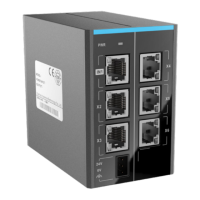11
To protect the communication cable from any tension and to ensure
communication stability, x the cable end which is near the device
before EtherCAT communication.
Conguration and use
1) When using this branch device, run all EtherCAT slaves (including the two
stations of this branch device) with an alias, so that an abnormal branch will
not aect the others.
2) The data ow priority of a 6-way branch device interface is X2>X3>X4>X5>X6, that is,
any slave on the X2 branch has priority over all slaves on the X3 branch.
3) The DC mode is enabled by default. That is, the branch device has been congured
as an EtherCAT slave in DC mode.
4) The branch device allows cascade, and the allowable number of nodes is not
restricted by the device.
5) Each branch device occupies two EtherCAT slave station numbers.
Fault Indication and Solutions
When the module fails, the user can check the signal status through the LED
indicator and take corresponding measures:
LED indicator
Indication Cause Solution
PWR
Link/
Act
OFF OFF
Power
failure
1. The power supply
is not connected
2. Internal circuit fault
1. Check power supply
connection
2. Replace the branch
module
ON OFF
Connection
not
established
1. The
communication cable
is disconnected or
short-circuited
2. Hardware fault of
the branch module
3. The master station
is not started
1. Check cable connection.
If cable breakage or short
circuit is found, replace the
communication cable
2. Replace the branch
module
③ Check the status of the
master

